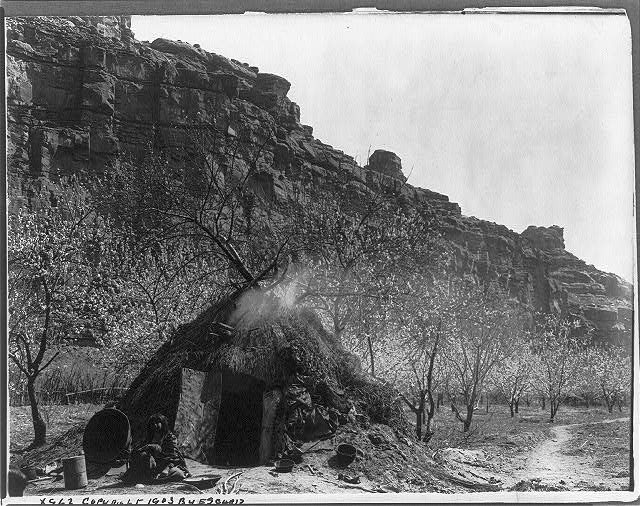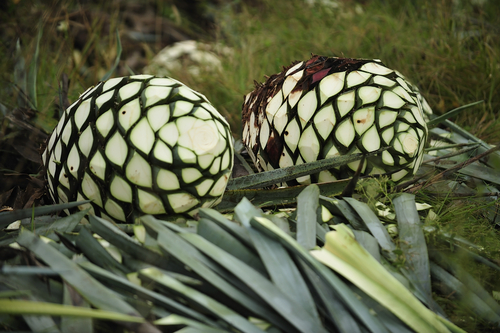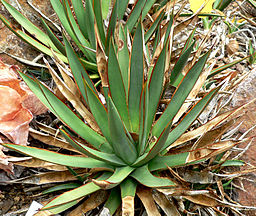Settlement and Subsistence Patterns
Before the Pai were confined to reservations, they followed a seasonal round focused on several key plant foods. Of two bands, the Havasupai relied on farming to a larger degree than the Hualapai and the seasonal rounds of the two bands varied slightly as a result.
For the Havasupai, the agricultural season began in mid-April when they returned to their summer settlements in the bottom of Cataract Canyon. There, they planted fields and constructed small irrigation ditches to water their crops. Harvesting began in June and continued until early fall, with the produce dried and stored for winter use. By mid-October the crops had all been harvested and the Havasupai returned to their winter homes on the plateau, taking their dried foods with them. There, they hunted deer and rabbit and harvested pinion nuts and other wild resources until it was time to return to the lowlands the following spring.

Havasupai woman seated in doorway of summer wickiup in Cataract Canyon, ca. 1903.
Source - http://www.loc.gov/pictures/item/2003652734/ Photograph by Edward S. Curtis.
The Hualapai spent far less time in one place. Rather than having two major moves during the year, they moved frequently to take advantage of plants ripening in different elevational zones. Early spring was spent camping in canyons and foothills where they gathered and processed large quantities of agave plants. Once collected, the leaves would be removed and the hearts baked in underground pits for several days.
Video one shows the setting up of the pit for an agave roast at the Desert Botanical Garden in Phoenix Arizona, along the Plants & People of the Sonoran Desert Loop Trail
Video two shows how the roast is done and people tasting the agave roast.
|
The non-fibrous inner core (which the cooking process converted into a sticky sweet substance, something roughly between the taste and texture of a dried apricot and a gummy worm) would be eaten right away, while the outer layers would be crushed into a pulp, dried in the sun, and stored. These dried slabs would later be boiled and then either eaten or mixed with water to produce a tasty beverage. The stems and leaves would be used to make sandals and cordage. |
|
|
Agave hearts, prepared for baking
Source - http://www.shutterstock.com/pic-291152354/stock-photo-agave-field-for-tequila-production-jalisco-mexico.html?src=ND6L2RxhKn8JC4d3BmoCWw-1-54 |
Agave Plant
Source - http://commons.wikimedia.org/wiki/File:Agave_arizonica_2.jpg |
|
Following the agave harvest, the Hualapai moved down to the canyon bottoms to gather wild resources and to plant crops. At the time of contact the Hualapai reportedly invested little effort or care in their crops, though some oral histories suggest that farming had been emphasized more in earlier times. After spending a few weeks in the canyon bottom, they moved back into the canyons and foothills to gather the fruit of various cactus, returning occasionally to check on their crops. Late summer and early fall were spent on the plateaus collecting pinion and juniper nuts, and winter was spent in large encampments on the plateau.
|
|
Click on next page to continue.


